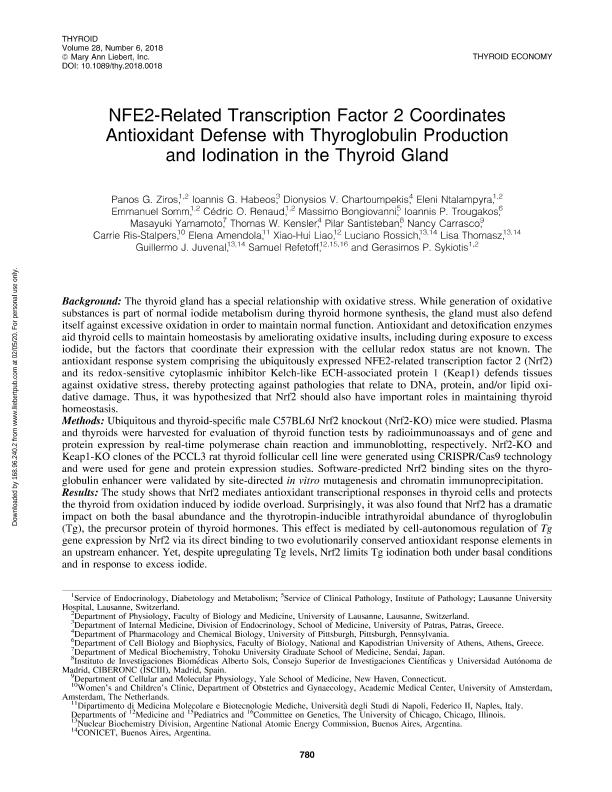Artículo
NFE2-Related transcription factor 2 coordinates antioxidant defense with thyroglobulin production and iodination in the thyroid gland
Ziros, Panos G; Habeos, Ioannis; Chartoumpekis, Dionysios V; Ntalampyra, Eleni; Somm, Emmanuel; Renaud, Cédric O.; Bongiovanni, Massimo; Trougakos, Ioannis P; Yamamoto, Masayuki; Kensler, Thomas W.; Santisteban, Pilar; Carrasco, Nancy; Ris Stalpers, Carrie; Amendola, Elena; Liao, Xiao-Hui; Rossich, Luciano Esteban ; Thomasz, Lisa
; Thomasz, Lisa ; Juvenal, Guillermo Juan
; Juvenal, Guillermo Juan ; Refetoff, Samuel; Sykiotis, Gerasimos P.
; Refetoff, Samuel; Sykiotis, Gerasimos P.
 ; Thomasz, Lisa
; Thomasz, Lisa ; Juvenal, Guillermo Juan
; Juvenal, Guillermo Juan ; Refetoff, Samuel; Sykiotis, Gerasimos P.
; Refetoff, Samuel; Sykiotis, Gerasimos P.
Fecha de publicación:
06/2018
Editorial:
Mary Ann Liebert
Revista:
Thyroid
ISSN:
1050-7256
Idioma:
Inglés
Tipo de recurso:
Artículo publicado
Clasificación temática:
Resumen
Background: The thyroid gland has a special relationship with oxidative stress. While generation of oxidative substances is part of normal iodide metabolism during thyroid hormone synthesis, the gland must also defend itself against excessive oxidation in order to maintain normal function. Antioxidant and detoxification enzymes aid thyroid cells to maintain homeostasis by ameliorating oxidative insults, including during exposure to excess iodide, but the factors that coordinate their expression with the cellular redox status are not known. The antioxidant response system comprising the ubiquitously expressed NFE2-related transcription factor 2 (Nrf2) and its redox-sensitive cytoplasmic inhibitor Kelch-like ECH-associated protein 1 (Keap1) defends tissues against oxidative stress, thereby protecting against pathologies that relate to DNA, protein, and/or lipid oxidative damage. Thus, it was hypothesized that Nrf2 should also have important roles in maintaining thyroid homeostasis. Methods: Ubiquitous and thyroid-specific male C57BL6J Nrf2 knockout (Nrf2-KO) mice were studied. Plasma and thyroids were harvested for evaluation of thyroid function tests by radioimmunoassays and of gene and protein expression by real-time polymerase chain reaction and immunoblotting, respectively. Nrf2-KO and Keap1-KO clones of the PCCL3 rat thyroid follicular cell line were generated using CRISPR/Cas9 technology and were used for gene and protein expression studies. Software-predicted Nrf2 binding sites on the thyroglobulin enhancer were validated by site-directed in vitro mutagenesis and chromatin immunoprecipitation. Results: The study shows that Nrf2 mediates antioxidant transcriptional responses in thyroid cells and protects the thyroid from oxidation induced by iodide overload. Surprisingly, it was also found that Nrf2 has a dramatic impact on both the basal abundance and the thyrotropin-inducible intrathyroidal abundance of thyroglobulin (Tg), the precursor protein of thyroid hormones. This effect is mediated by cell-autonomous regulation of Tg gene expression by Nrf2 via its direct binding to two evolutionarily conserved antioxidant response elements in an upstream enhancer. Yet, despite upregulating Tg levels, Nrf2 limits Tg iodination both under basal conditions and in response to excess iodide. Conclusions: Nrf2 exerts pleiotropic roles in the thyroid gland to couple cell stress defense mechanisms to iodide metabolism and the thyroid hormone synthesis machinery, both under basal conditions and in response to excess iodide.
Palabras clave:
ANIMAL TESTING ALTERNATIVES
,
IODIDE
,
NRF2
,
OXIDATIVE STRESS
,
THYROGLOBULIN
,
THYROID
Archivos asociados
Licencia
Identificadores
Colecciones
Articulos(SEDE CENTRAL)
Articulos de SEDE CENTRAL
Articulos de SEDE CENTRAL
Citación
Ziros, Panos G; Habeos, Ioannis; Chartoumpekis, Dionysios V; Ntalampyra, Eleni; Somm, Emmanuel; et al.; NFE2-Related transcription factor 2 coordinates antioxidant defense with thyroglobulin production and iodination in the thyroid gland; Mary Ann Liebert; Thyroid; 28; 6; 6-2018; 780-798
Compartir
Altmétricas



